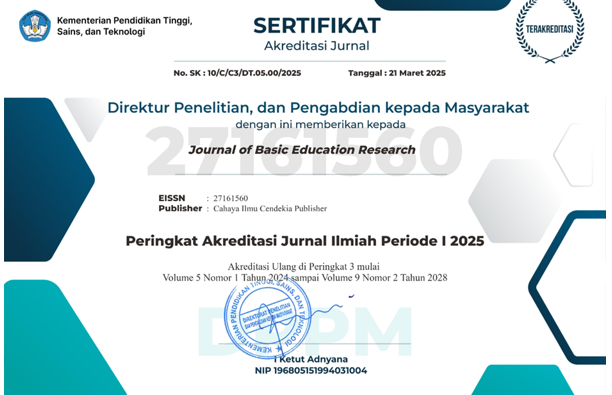Local Wisdom of Wayang Figures: Building of Student Character
Abstract
Purpose of the Study: This study aims to explore and analyze how character education can be developed through the integration of local wisdom, specifically using wayang (puppet) characters at Segulung 05 Elementary School. It investigates both the challenges and supporting factors in using wayang as a medium for character-building, and the overall impact on students. This approach is particularly interesting due to the deep cultural heritage of wayang on the island of Java, where each puppet character embodies moral values and life lessons that can be applied to everyday behavior.
Methodology: This research utilizes a case study approach within a qualitative framework. Data was gathered through interviews, observations, and document analysis, focusing on the implementation of wayang in teaching moral values.
Main Findings: The study reveals that character building through wayang involves not just storytelling but the use of wayang characters as moral role models, integrated into lessons in Javanese language and culture. Students engage with the rich symbolism of wayang, although variation in teaching methods is necessary to prevent disengagement. Despite potential challenges, wayang serves as an effective and captivating tool for instilling values, showing a positive impact on student character and increasing cultural awareness.
Novelty/Originality of this Study: This study presents a novel approach to character education by incorporating traditional Javanese wayang as a teaching medium. It demonstrates that local cultural elements can serve as powerful tools for character development, contributing uniquely to educational practices and the preservation of cultural heritage.
References
I. Mujahid, “Islamic orthodoxy-based character education: creating moderate Muslim in a modern pesantren in Indonesia,” Indones. J. Islam Muslim Soc., vol. 11, no. 2, pp. 185–212, 2021, doi: 10.18326/ijims.v11i2.185-212.
N. A. Hidayati, H. J. Waluyo, R. Winarni, and Suyitno, “Exploring the implementation of local wisdom-based character education among indonesian higher education students,” Int. J. Instr., vol. 13, no. 2, pp. 179–198, 2020, doi: 10.29333/iji.2020.13213a.
G. Santoso and M. Murod, “Comparison of the contents pancasila education and citizenship from 1975-2013 curriculum in Indonesian at the 21st Century,” J. Ekon., vol. 21, no. 2, pp. 65–71, 2021, doi: 10.29138/je.v21i2.148.
K. E. Smith and S. D. Pollak, “Early life stress and development: potential mechanisms for adverse outcomes,” J. Neurodev. Disord., vol. 12, no. 1, p. 34, 2020, doi: 10.1186/s11689-020-09337-y.
M. D. N. Hadi Mousavi, “A new decade for social changes,” Tech. Soc. Sci. J., vol. 6, no. December, pp. 101–105, 2020, doi: doi.org/10.47577/tssj.v33i1.6845.
O. Yanto, Y. M. Darusman, S. Susanto, and A. D. Harapan, “Legal protection of the rights of the child victims in Indonesian juvenile criminal justice system,” J. Yustika Media Huk. Dan Keadilan, vol. 23, no. 01, pp. 24–35, 2020, doi: 10.24123/yustika.v23i01.2818.
Y. K. Saputra, M. Dylan, and D. Carmelo, “Fostering islamic morality through tahfidz learning: Islamic law,” Int. J. Educ. Narrat., vol. 1, no. 2, pp. 49–62, 2023, doi: 10.55849/ijen.v1i2.305.
Aningsih, M. S. Zulela, A. Neolaka, V. Iasha, and B. Setiawan, “How is the education character implemented? the case study in Indonesian elementary school,” J. Educ. Soc. Res., vol. 12, no. 1, pp. 371–380, 2022, doi: 10.36941/jesr-2022-0029.
M. Taufik, “Strategic role of islamic religious education in strengthening character education in the era of industrial revolution 4.0,” J. Ilm. Islam Futur., vol. 20, no. 1, pp. 86–104, 2020, doi: 10.22373/jiif.v20i1.5797.
R. Widialistuti, J. Jamaris, and S. Solfema, “Internalisasi dalam pembentukan karakter melalui penerapan nilai kearifan lokal pada pembelajaran matematika di sekolah dasar,” J. Basicedu, vol. 7, no. 1, pp. 106–115, 2023, doi: 10.31004/basicedu.v7i1.4332.
D. Puspitarini, “Blended learning sebagai model pembelajaran abad 21,” Ideguru J. Karya Ilm. Guru, vol. 7, no. 1, pp. 1–6, 2022, doi: 10.51169/ideguru.v7i1.307.
A. Mappaenre, A. Hasanah, B. Samsul Arifin, Y. Nuraini, and R. Satria Wiwaha, “The implementation of character education in madrasah,” Attadrib J. Pendidik. Guru Madrasah Ibtidaiyah, vol. 5, no. 2, pp. 166–181, 2023, doi: 10.54069/attadrib.v5i2.302.
S. Syarnubi, F. Mansir, M. E. Purnomo, K. Harto, and A. Hawi, “Implementing character education in madrasah,” J. Pendidik. Islam, vol. 7, no. 1, pp. 77–94, 2021, doi: 10.15575/jpi.v7i1.8449.
A. Hermino and I. Arifin, “Contextual character education for students in the senior high school,” Eur. J. Educ. Res., vol. 9, no. 3, pp. 1009–1023, 2020, doi: 10.12973/EU-JER.9.3.1009.
I. Ruslan et al., “Tradisi ritual dalam pernikahan islam Jawa (studi di desa kalidadi Lampung Tengah),” Anal. J. Stud. Keislam., vol. 24, no. 1, pp. 85–112, 2024, doi: 10.24042/ajsk.v24i1.22383.
P. B. Kambuaya, M. K. P. Kambuaya, and S. E. Msi, “Economic empowerment of local wisdom-based papuan communities,” SADI J. Econ. Soc. Sci., vol. 11, no. 2, pp. 18–30, 2024, doi: 10.5281/zenodo.12166417.
F. Nuryantiningsih and S. N. Hari Yanti, “Heroic figures’ characters in wayang wong dance drama: A character education for the elementary school students?,” J. Ling. Idea, vol. 12, no. 1, p. 69, 2021, doi: 10.20884/1.jli.2021.12.1.3432.
F. F. Nurafifah, M. E. Simbolon, and M. Noviana, “the effect of Wayang media on folklore listening skills,” Indones. J. Elem. Teach. Educ., vol. 2, no. 1, pp. 20–28, 2021, doi: 10.25134/ijete.v2i1.4096.
M. M. Hossain, “Moral values in Western and Indonesian stories: A research on the stories for the Ninth Grade of Junior High School Eros,” J. English Educ. Teach., vol. 2, no. 1, pp. 89–97, 2016, doi: 10.33369/jeet.4.3.449-465.
N. Pearse, “Guidelines for Theory Development using Qualitative Research Approaches,” Electron. J. Bus. Res. Methods, vol. 19, no. 2, pp. 95–103, 2021, doi: 10.34190/EJBRM.19.2.2512.
B. I. Ansari, T. Taufiq, and S. Saminan, “The use of creative problem solving model to develop students’ adaptive reasoning ability: Inductive, deductive, and intuitive,” Int. J. Teach. Learn. Math., vol. 3, no. 1, pp. 23–36, 2020, doi: 10.18860/ijtlm.v3i1.9439.
A. J. Bingham, “From data management to actionable findings: A five-phase process of qualitative data analysis,” Int. J. Qual. Methods, vol. 22, pp. 1–11, 2023, doi: 10.1177/16094069231183620.
J. Praful Bharadiya, “A comparative study of business intelligence and artificial intelligence with big data analytics,” Am. J. Artif. Intell., vol. 7, no. 1, pp. 24–30, 2023, doi: 10.11648/j.ajai.20230701.14.
N. L. O. P. D. Omolola A. Adeoye-Olatunde Pharm.D., M.S., “Research and scholarly methods: Semi-structured interviews,” J. Am. collage Clin. Pharm., vol. 4, no. 10, pp. 1358–1367, 2021, doi: 10.1002/jac5.1441.
V. U. Pratiwi, Andayani, R. Winarni, and A. Anindyarini, “Digital storybook to transform character education of local wisdom figures for elementary school students,” J. Soc. Stud. Educ. Res., vol. 13, no. 4, pp. 250–264, 2022, doi: 10.23887/jpp.v54i1.
I. P. Y. Purandina and K. A. Wedananta, “Spirit of Balinese local heroes transformed into puppets show on youtube as elt media for building students’ character,” J. Pendidik. dan Pengajaran, vol. 54, no. 1, p. 80, 2021, doi: 10.23887/jpp.v54i1.33001.
A. C. Eldh, L. Årestedt, and C. Berterö, “Quotations in qualitative studies: reflections on constituents, custom, and purpose,” Int. J. Qual. Methods, vol. 19, pp. 1–6, 2020, doi: 10.1177/1609406920969268.
D. L. Morgan and A. Nica, “Iterative thematic inquiry: A new method for analyzing qualitative data,” Int. J. Qual. Methods, vol. 19, pp. 1–11, 2020, doi: 10.1177/1609406920955118.
M. Zairul, “Can member check be verified in real time? Introducing arc (asking, record, confirm) for member checking validation strategy in qualitative research,” Eng. J., vol. 25, no. 1, pp. 245–251, 2021, doi: 10.4186/ej.2021.25.1.245.
H. A. Abd, A. Majid, and H. Al-Atabi, “Research Self-Efficacy among postgraduate students,” J. Namibian Stud., vol. 34, p. 1, 2023, doi: 10.59670/jns.v34i.2954.
S. Prahara, A. Aneta, Z. Abdussamad, and ..., “Bureaucratic transformation through village arrangements in gorontalo regency,” J. Surv. …, vol. 10, pp. 4752–4764, 2023, doi: 10.17762/sfs.v10i3S.1668.
H. V. Saphira, “Integrating local wisdom-based learning to preparing the pancasila students’ profile, Yes or No?,” Int. J. Curr. Educ. Res., vol. 1, no. 1, pp. 18–35, 2022, doi: 10.53621/ijocer.v1i1.136.
U. Seno, S. Narimo, D. Fuadi, M. Minsih, and C. Widyasari, “Implementation of local wisdom based learning in realizing pancasila student profiles in elementary schools,” J. Ilm. Sekol. Dasar, vol. 6, no. 4, pp. 652–660, 2022, doi: 10.23887/jisd.v6i4.56041.
Copyright (c) 2024 Dwi Rahhayu Noritasari, Mae Caroline J. Tolibas

This work is licensed under a Creative Commons Attribution 4.0 International License.
Authors who publish with this journal agree to the following terms:
- Authors retain copyright and acknowledge that the Journal of Basic Education Research is the first publisher licensed under a Creative Commons Attribution 4.0 International License.
- Authors are able to enter into separate, additional contractual arrangements for the non-exclusive distribution of the journal's published version of the work (e.g., post it to an institutional repository or publish it in a book), with an acknowledgment of its initial publication in this journal.
- Authors are permitted and encouraged to post their work online (e.g., in institutional repositories or on their website) prior to and during the submission process, as it can lead to productive exchanges and earlier and greater citation of published work.





.png)


.png)
.png)


















